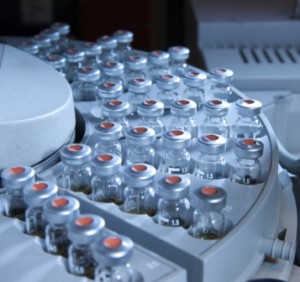Gas Explosion 1977 – The King Inquiry
Following several gas explosions over the Christmas and New Year period of 1976/77, the Secretary of State for Energy commissioned an inquiry chaired by Dr P J King, to examine the circumstances surrounding the incidents and to consider improvements to existing procedures or systems, and new measures which might reasonably be implemented to lead to reduction in such incidents. Although the laying of cast iron mains ceased some years before the inquiry, in the late 1960s, at that time about 80% of the distribution system consisted of this material.
In Response
In response to the implications of Natural Gas conversion and the findings of the King Report, British Gas undertook an intensive research and development program to establish a mechanism for reducing the leakage from lead yard joints. The final outcome resulted in the injection and vaporisation of mono-ethylene glycol into the gas system, now known as Gas Conditioning or Fogging.
Effectiveness
Many studies have been conducted into the effectiveness of Gas Conditioning over the years. All have shown; efficient well maintained conditioning systems dramatically reduce the leakage from lead yarn joints.
Cost Effectiveness
Several small studies have been conducted into the costs associated Gas Conditioning and the returns in reduced leakage repairs. Again effective well maintained systems do demonstrate a net financial benefit, but this is not the main reason for the activity.
Risk Management
Risk management is essential in every business, and Gas Transporters play a vital role in ensuring the safe distribution of gas in the UK. The decision making process for assessing risk by the HSE is described in “Reducing Risks, Protecting People.” This publication explains the decision making process in HSE when assessing risk.
The overall framework for decision taking in the Gas Industry must have consistency and coherence across the full range of risks falling within the scope of the Health and Safety at Work etc. Act 1974. Guidance to duty-holders on what they need to do is available in other documents such as the ‘Management of Health and Safety Regulations 1999, Approved Code of Practice and guidance’, ‘A Guide Pipelines Safety Regulations 1996’ and ‘A guide to the Gas Safety (Management) Regulations 1996’.
In response to this, companies have developed: Policies, Organisation, Procedures, Monitoring, Audit and Review procedures to ensure the safe transportation and supply of gas to the user.
“Gas conditioning currently forms a major part of the safety case presented by some Gas Transporters.”
Maintenance Activities and Policy
The Pipelines Safety Regulations 1996 places a duty on the operator of a pipeline to ensure that a pipeline is maintained in an efficient state, in efficient working order and in good repair. The guidance explains that it is a requirement to maintain the pipeline to secure its safe operation and to prevent loss of containment and that the extent of work done to maintain a pipeline will depend on its material of construction, its location, the fluid conveyed and the condition under which it is operated. The document “Recommendations on Transmission and Distribution Practice” IGE/TD/329 issued by The Institution of Gas Engineers states that the objective of maintenance is to preserve the asset, to ensure a safe and adequate supply to the consumer and, when leakages do occur, to deal with them quickly and effectively. It goes on to state that emphasis should be on preventative (proactive) measures in preference to remedial (reactive) measures. Some transporters undertakes proactive maintenance such as gas conditioning to reduce joint leakage and gas pressure management to reduce system pressures. Mains replacement can be considered proactive where mains are replaced before they fail.
Justified Reduction in General Distribution Mains Surveys
Proposals made to HSE to discontinue GDMS have been made by placing more emphasis on leakage reduction at source by gas conditioning, pressure management and mains replacement. This can be justified on the basis that the majority of leaks were reported by the public with only 1% being detected by Safety Surveys.
However this only works if conditioning systems are maintained and serviced correctly. Poor maintenance and attention results in falling saturation levels and increased leakage.
Potential Implications of Stopping Gas Conditioning
The theory of Gas Conditioning is rather simple, “a wetting agent is injected with the dry gas supply to a lead yard network, the yarns are then kept moist and the joints remain in good condition, therefore leakage is reduced.” In practice the mechanism is far more complex and dynamic, requiring a reasonable amount of attention and maintenance. If conditioning is stopped, yarns will in a relatively short period start to dry out and deteriorate, eventually turning to dust. (See industry response to King Report)
The potential for a dramatic increase in leakage levels and incidents is therefore self-explanatory. Both the number of hazards and therefore risk will increase.
Depreciation of Asset Value
Further to all the implications already mentioned, the effect of stopping or reducing gas conditioning is a significant reduction in asset value. Once lost, this can never be regained in the future as yarn degradation becomes irreversibly in a relatively short time.
Conclusions
Gas conditioning has played an important role in Risk Management within the domestic gas industry for over 30 years. It has been used as evidence on many occasions for compliance with legislation and industry codes of practice. Well maintained systems regularly demonstrate good saturation levels. Careful monitoring of mains replacement programs and the locating of foggers ensure cost effective management and reduce MEG wastage.
Support
Scienco run seminars and user support meetings for those who are interested in getting the best from their MEG systems. Such group meeting have resulted in one user obtaining an average of 75% saturations across their network from simple Norgren foggers by using ultrasonic cleaning of injector heads.

If you would like further information on this subject or assistance, follow the contact link below or call us on 0845 6039053.